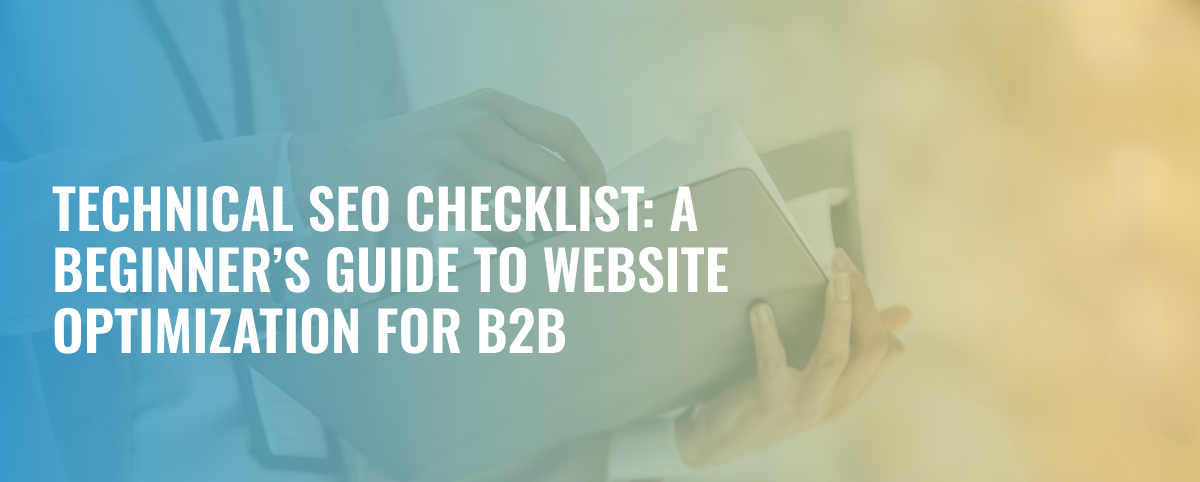9 minute read
Technical SEO Checklist: A Beginner’s Guide to Website Optimization for B2B
In today’s competitive digital landscape, optimizing your B2B website for search engines is no longer just about producing high-quality content. The technical aspects of your site are equally important to ensure your website is visible, performs well, and ranks higher on search engines. This is where a technical SEO checklist becomes an essential tool for any B2B business looking to improve its website’s search engine performance.
In this guide, we’ll walk through the key elements of a technical SEO checklist that will help you optimize your B2B website for search engines, increase visibility, and drive more qualified traffic.
Conduct a Website SEO Audit
At the top of your checklist should be a comprehensive website SEO audit. This audit gives you a full view of how your website is performing technically and what areas need improvement. During the audit, you should assess the following:
-
Site Architecture
Is your site organized logically? Ensure pages are easy to find and navigate.
-
URLs
Are your URLs clean, readable, and optimized with relevant keywords?
-
Metadata
Evaluate the quality and relevance of your title tags and meta descriptions. These are important for both search engines and users.
-
Internal Linking
Is your internal linking structure helping users and search engines move through your site easily?
By understanding the state of these elements, you can identify any technical issues that might be hindering your website’s performance.
Optimize Website Speed
Website speed optimization is one of the most important components of technical SEO. Page load speed is not only a ranking factor for search engines, but it also plays a crucial role in user experience. Slow websites frustrate visitors, which can increase bounce rates and ultimately hurt your search engine rankings.
To optimize your website’s speed, consider the following actions:
-
Compress Images
Use tools like TinyPNG or ImageOptim to reduce file sizes without compromising quality.
-
Reduce Server Response Time
Minimize time spent waiting for the server to respond by using reliable hosting and content delivery networks (CDNs).
-
Leverage Browser Caching
Store static files on visitors’ browsers so your website loads faster when they return.
The faster your website, the more likely users will stay, explore, and convert—especially important for B2B websites where decisions often require multiple interactions.
Ensure Mobile Optimization
In the B2B world, mobile optimization is critical. With an increasing number of decision-makers accessing websites through mobile devices, it’s essential to provide a seamless user experience across all screen sizes. A mobile-friendly website can also help boost your rankings since Google considers mobile-first indexing when determining search engine rankings.
Key mobile optimization strategies include:
-
Responsive Design
Ensure your site adapts to different screen sizes and devices without compromising functionality.
-
Optimize Images and Fonts
Make sure your images are resized appropriately for mobile screens and that text is readable without zooming.
-
Streamline Layouts
Create a clean and simple layout that makes navigation easy, even on smaller screens.
By prioritizing mobile optimization, you can improve your chances of ranking higher and providing a better experience for your users, regardless of their device.
Indexing and Crawling
Indexing and crawling are essential parts of technical SEO that involve making sure search engines can access, read, and store your website’s information. If search engines can’t crawl your site properly, it won’t be indexed, and thus won’t appear in search results.
Here’s how to ensure your website is crawlable:
-
Create an XML Sitemap
This helps search engines discover and index all of your important pages.
-
Check Your Robots.txt File
Ensure you’re not accidentally blocking important pages from being crawled.
-
Monitor Crawl Errors
Use tools like Google Search Console to identify and fix any errors that prevent search engines from crawling your site.
A well-indexed website is critical for search engine visibility, so make sure this part of your SEO strategy is airtight.
Optimize On-Page SEO Elements
On-page SEO is about optimizing individual pages for specific keywords while maintaining a good user experience. This involves making sure your title tags, meta descriptions, and headers are relevant, keyword-rich, and align with user intent.
When optimizing on-page SEO for B2B websites, follow these steps:
-
Use Keywords Strategically
Identify primary and secondary keywords that align with your audience’s search intent and integrate them naturally into your title tags, meta descriptions, and headers.
-
Avoid Keyword Stuffing
While keywords are important, overloading your content with them can harm both user experience and rankings.
-
Focus on Content Value
Ensure that your pages provide real value and answers to the queries users are searching for.
The goal of on-page SEO is to make each page more visible to search engines while improving the user experience for those who visit your site.
Implement Structured Data (Schema Markup)
Structured data, or schema markup, helps search engines understand your website content in greater detail. For B2B websites, this can be particularly beneficial as it allows search engines to better categorize and display relevant information about your business.
Some common types of schema markup for B2B websites include:
-
Organization Schema
Provides detailed information about your company (location, contact details, etc.).
-
Product Schema
Helps highlight products or services you offer, making them more visible in search results.
-
Breadcrumb Schema
Improves the way your internal linking structure is displayed in search results, helping users navigate your site more easily.
By implementing structured data, you can enhance your search engine visibility and improve click-through rates from search results.
Secure Your Website with HTTPS
A secure website is not just important for protecting your visitors—it’s also a ranking factor. Websites using HTTPS instead of HTTP are seen as more secure and trustworthy by both users and search engines.
If your website isn’t already secure, make it a priority to switch to HTTPS by obtaining an SSL certificate.
Fix Broken Links and 404 Errors
Broken links and 404 errors can damage both user experience and SEO. These errors occur when a link on your website leads to a page that no longer exists.
To fix broken links:
-
Use a Tool
Tools like Screaming Frog or Ahrefs can help you identify broken links on your website.
-
Redirect
Implement 301 redirects to guide users (and search engines) to the correct pages.
Keeping your links up to date will help maintain a smooth user experience and improve search engine rankings.
Conclusion
By following this technical SEO checklist, you can ensure your B2B website is optimized for both users and search engines. From conducting regular SEO audits to improving website speed, mobile optimization, and implementing structured data, each of these steps will contribute to your website’s visibility and search engine performance.
Take the time to implement these best practices, and you’ll not only enhance your search rankings but also provide a better user experience—ultimately driving more traffic and leads to your B2B website.

